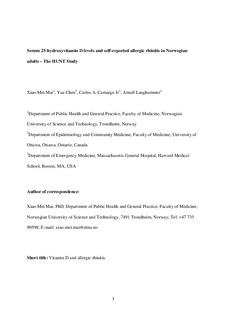| dc.contributor.author | Mai, Xiao-Mei | |
| dc.contributor.author | Chen, Yue | |
| dc.contributor.author | Camargo, Carlos A | |
| dc.contributor.author | Langhammer, Arnulf | |
| dc.date.accessioned | 2017-06-12T08:46:50Z | |
| dc.date.available | 2017-06-12T08:46:50Z | |
| dc.date.created | 2014-10-01T14:34:41Z | |
| dc.date.issued | 2014 | |
| dc.identifier.citation | Allergy. European Journal of Allergy and Clinical Immunology. 2014, 69 (4), 488-493. | nb_NO |
| dc.identifier.issn | 0105-4538 | |
| dc.identifier.uri | http://hdl.handle.net/11250/2445742 | |
| dc.description.abstract | Background
The role of low vitamin D status in the development of allergic rhinitis is unclear. We aimed to investigate the relationship between serum 25-hydroxyvitamin D [25(OH)D] and incidence of allergic rhinitis in adults.
Methods
The study included a random sample from an adult population who participated in the second and third surveys of the Nord-Trøndelag Health Study (HUNT) in Norway (HUNT2, 1995–1997 and HUNT3, 2006–2008). Serum 25(OH)D levels were measured in blood samples collected at baseline. Among 1351 adults who did not report allergic rhinitis at baseline, incident allergic rhinitis was identified by participant report of having or having had allergic rhinitis or hay fever at follow-up. Adjusted odds ratios (AOR) and 95% confidence intervals (CI) were calculated after adjustment for age, smoking, physical activity, socioeconomic status, family history of allergy, body mass index, and season. The analyses were stratified by sex due to its significant interaction with 25(OH)D levels (P < 0.02).
Results
Over an average of 11 years, 9% of men and 15% of women developed allergic rhinitis. Among men, serum 25(OH)D level <50 nM was associated with an increased risk of incident allergic rhinitis (AOR 2.55; 95% CI 1.01–6.49); each 25 nM reduction in 25(OH)D level was associated with an AOR of 1.84 (95% CI 1.18–2.87). In women, however, the association was opposite, with AOR being 0.83 (95% CI 0.66–1.05) for each 25 nM reduction in serum 25(OH)D level.
Conclusions
Vitamin D appears to play different roles in the development of allergic rhinitis among men and women. | nb_NO |
| dc.language.iso | eng | nb_NO |
| dc.publisher | Wiley | nb_NO |
| dc.relation.uri | http://onlinelibrary.wiley.com/doi/10.1111/all.12365/pdf | |
| dc.title | Serum 25-hydroxyvitamin D levels and self-reported allergic rhinitis in Norwegian adults - The HUNT Study | nb_NO |
| dc.type | Journal article | nb_NO |
| dc.type | Peer reviewed | nb_NO |
| dc.description.version | acceptedVersion | nb_NO |
| dc.source.pagenumber | 488-493 | nb_NO |
| dc.source.volume | 69 | nb_NO |
| dc.source.journal | Allergy. European Journal of Allergy and Clinical Immunology | nb_NO |
| dc.source.issue | 4 | nb_NO |
| dc.identifier.doi | 10.1111/all.12365 | |
| dc.identifier.cristin | 1160492 | |
| dc.relation.project | Norges forskningsråd: 201895 | nb_NO |
| dc.description.localcode | This is the peer reviewed version of the following article: Serum 25-hydroxyvitamin D levels and self-reported allergic rhinitis in Norwegian adults – The HUNT Study, which has been published in final form athttp://onlinelibrary.wiley.com/doi/10.1111/all.12365/full. This article may be used for non-commercial purposes in accordance with Wiley Terms and Conditions for Self-Archiving. | nb_NO |
| cristin.unitcode | 194,65,20,0 | |
| cristin.unitname | Institutt for samfunnsmedisin | |
| cristin.ispublished | true | |
| cristin.fulltext | postprint | |
| cristin.qualitycode | 1 | |
